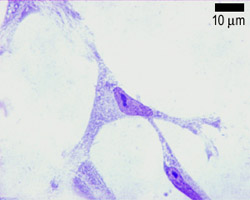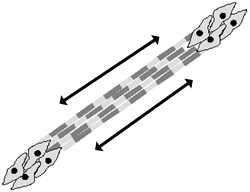Fibroblasts secrete collagen and elastin; fibres in the extracellular matrix (ECM).
(Fibra - latin for fibre, blastos - greek for germ)
They are the least specialised of the connective tissue cells and can differentiate into other cell types found in the ECM.
Fibroblasts are spindle shaped, and actively secreting matrix. Their cytoplasm is basophilic, so there will be quite a lot of purplish blue staining of the cytoplasm, using the H&E stain.
Adults tend to have less active fibroblasts, called fibrocytes, which have paler stained cytoplasm.
 This is a picture of an active fibroblasts. Note the prominent nucleus, and nucleoli, granular cytoplasm and cellular extensions.
This is a picture of an active fibroblasts. Note the prominent nucleus, and nucleoli, granular cytoplasm and cellular extensions.

